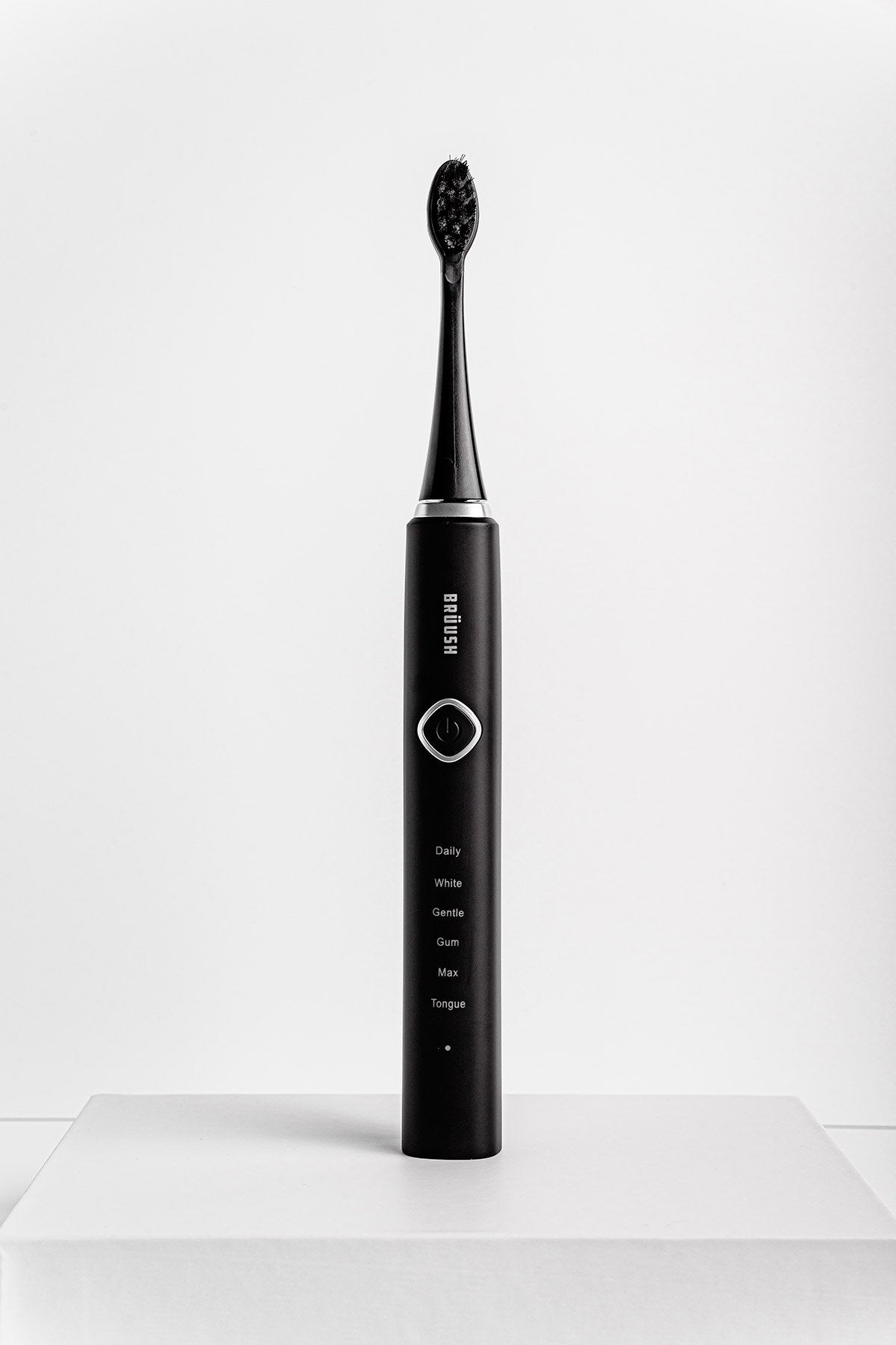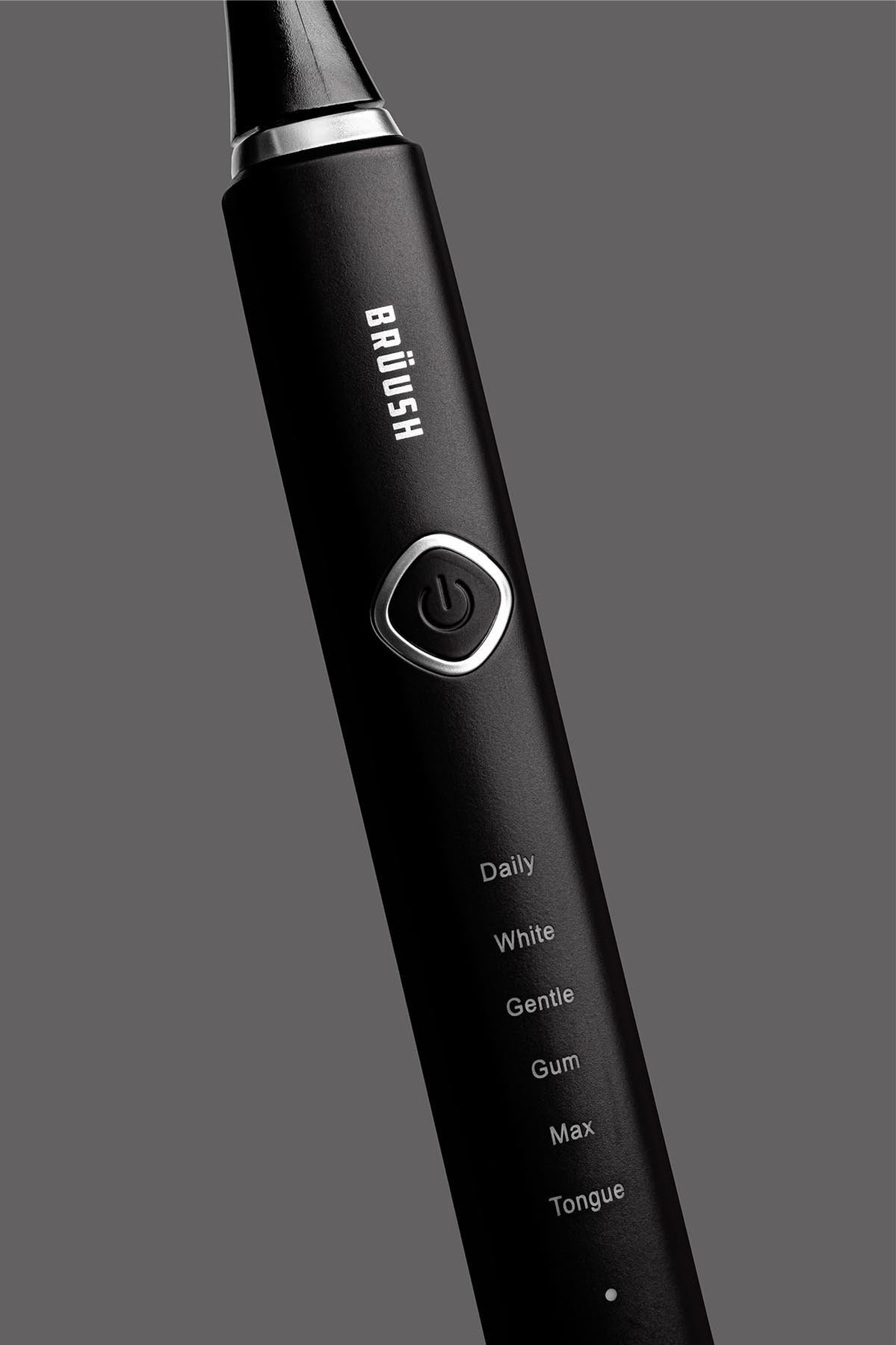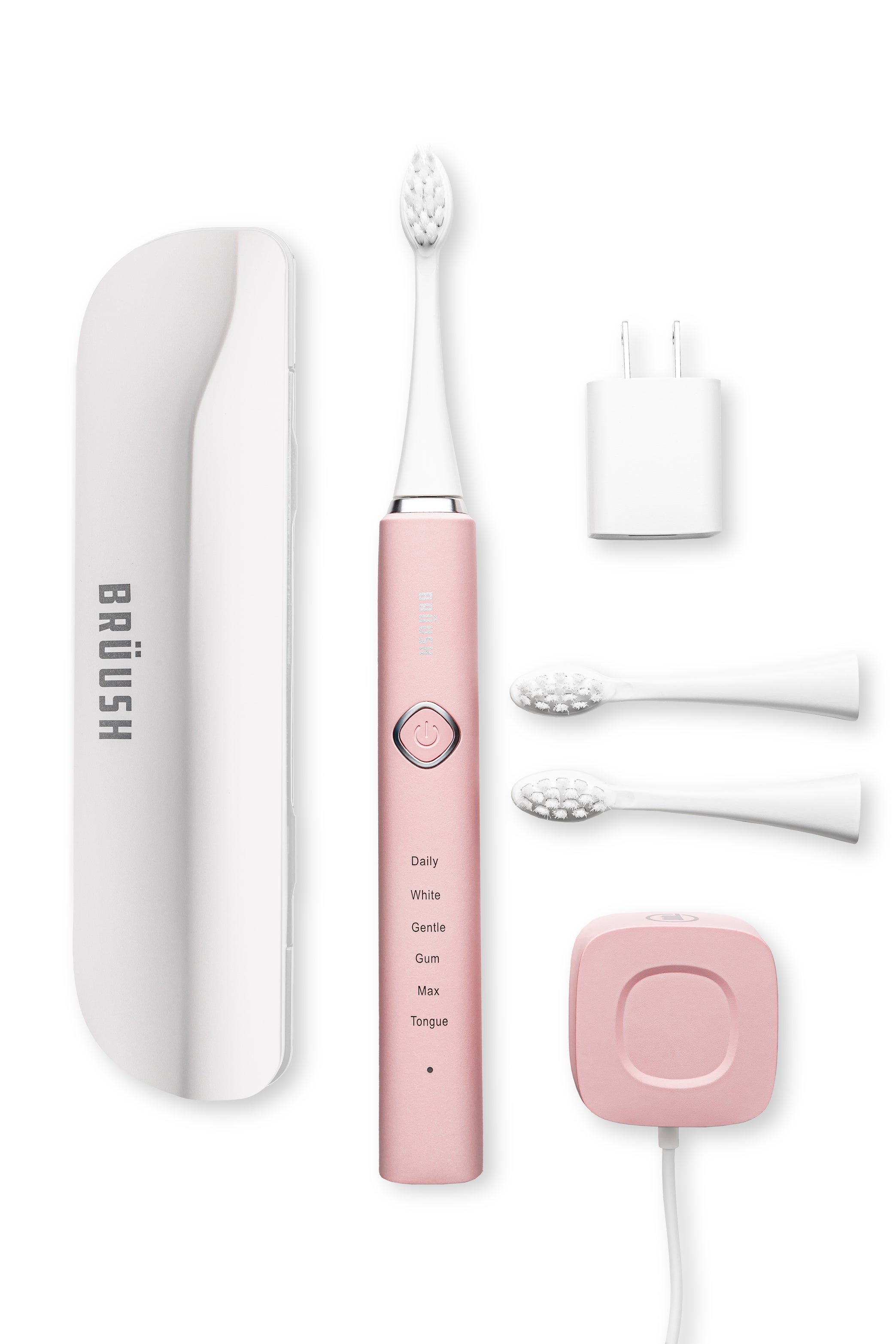Overbrushing or improper tooth brushing—it’s a thing.
Whether you’re brushing your teeth too hard, haven’t flossed in 4 months, or are using an old toothbrush, there are many factors that could be having a negative impact on your gum health. And when you’re using an electric toothbrush that comes with a lot of power, you need to make sure you’re brushing properly (more on that later).
So now that we’ve got you thinking about gum health, let’s dive into:
- What exactly receding gums are, how they come about, and why you should care
- The most common symptoms of gum recession
- Whether electric toothbrushes cause receding gums, or if they can actually improve your gum health
- How to choose the best electric toothbrush for your oral health needs
- Some quick tips for using an electric toothbrush properly
What Are Receding Gums?
One of the most common dental issues, (and something that your dentist or a dental hygienist takes note of each time you enter their office for a checkup), is gum recession. Also known as gingival recession, often it’s not something to worry about, until it is.
Receding gums are a gradual reduction of gum tissue along the gum-tooth line. They gradually wear away or push back from their original position to show more of the tooth underneath, also known as “pockets”. And guess what likes to hide in the grooves and gap between your teeth and gums? Bacteria. Overtime, if this bacteria gets stuck, it can cause some serious tooth and bone structure damage.
This is why it’s imperative that your dentist is measuring and tracking the pocket depth of the grooves between your gums and teeth every check-up. Healthy gums should have a pocket depth of 1 and 3 millimetres—anything above this (4 mm+) could indicate early periodontitis, also known as gum disease.
What Causes Gum Recession?
As we eluded to above, there are a handful of factors that can lead to receding gums—some associated with cleaning your teeth TOO much (yes, it is possible to over-clean your teeth), while others from a lack of proper oral care.
Here are 7 common causes of gum recession:
- You’ve got bad genes. Okay, so bad isn’t the right word. Depending on your genetic makeup, you could be more susceptible to getting gum disease. Some studies show that up to 30% of people could have this predisposition.
- You’re brushing too hard. Your gums are delicate, and as such you need to be cognizant of your brushing pressure. When you overbrush your teeth, you’re more likely to damage your gums.
- You’re brushing way more in some areas than others. It’s imperative that you spend an equal amount of time in each quadrant of your mouth. Spending significantly longer in some spots can lead to gum recession over time due to the extra wear and tear on that area.
- You’re brushing downwards, not side-to-side. The angle at which you brush your teeth is key to good gum health. Brushing side-to-side on a 45 degree angle ensures that you’re not pushing your gums up or down.
- You don’t brush or floss ENOUGH. If you aren’t brushing properly every morning and evening, and flossing once per day, it could lead to bacteria buildup underneath your gums. Overtime, when left to their own devices, bacteria can cause cavities, turn into plaque, and progress to gingivitis and then periodontitis.
- You’ve got periodontal disease. Speaking of, if you find yourself with sore, inflamed, red gums, you could have some form of periodontal disease (the leading cause of gum recession). At this stage of gum disease, bacteria destroys gum tissue and tooth/bone, causing a whole mess in your mouth.
- You’re going through hormonal changes. This one is specifically for females. As you age, going through puberty, possibly pregnancy, and then menopause, these fluctuations in female hormones can lead to gum sensitivity. The more sensitive your gums, the more likely you are to damage them, leading to gum recession.
What Are The Symptoms Of Gum Recession?
So maybe by now you’re thinking “Do I have gum recession?”. Though it’s possible that you could have the beginnings of it, if there are no glaring signs… you probably don’t have it.
We say this because the symptoms of gum recession are quite glaring. You can either notice it visually, or feel the effects yourself.
Here are some typical symptoms to look out for:
- Swollen, red gums (ouch!)
- Pain/sensitivity at or along your gum line
- Loose or wobbly teeth (we’re talking adult teeth, not baby ones)
- Shrinking gums that are retreating away from the teeth
- Consistent bad breath that doesn’t have to do with eating something garlicky
- Noticeable bleeding after you floss or brush
Do Electric Toothbrushes Damage Gums?

The short and mainly inaccurate answer is yes, electric toothbrushes CAN damage your gums. But, so can a manual toothbrush. Brushing too hard or improperly can always lead to gum recession.
The key to using an electric toothbrush is to be very gentle. They’re moving at a much faster rate than a manual brush, and with that comes more scrubbing power. The Brüush electric toothbrush moves at 31,000 strokes per minute—try moving that fast with your own hand!
Poor Brushing Technique
Since we’re on the topic of brushing habits, poor brushing technique can lead to some pretty bad gum damage. It’s ironic because people who brush more may think they’re doing their teeth a favour, BUT, over brushing that can lead to gum recession. And of course underbrushing (or not brushing enough), can lead to plaque buildup and worse.
So, here are some proper brushing techniques to adhere to:
- Make sure the toothbrush head is at a 45-degree angle to your teeth
- Use light pressure and brush equally in all 4 quadrants of your mouth—that means front, back, and chewing surfaces of your teeth
- When using an electric, just simply move the brush around (no need for back and forth motion)
- Brush for a total of 2 minutes, so 30 seconds per quadrant
- It’s okay to give yourself a deeper clean (say, 3 minutes), every once in a while, but if you overdo it you could damage your gums
How Electric Toothbrushes Help With Gum Recession
What if we told you that electric toothbrushes can actually prevent gum damage? Well, they can. They give you a better clean with less effort on your end! Particularly for people with mobility/dexterity issues like arthritis, the fast brush strokes associated with power toothbrushes help to do the heavy lifting when it comes to scrubbing your teeth clean.
Electric toothbrushes are clinically proven to remove plaque better than a manual toothbrush—up to 21% more, to be exact. And since plaque is the first step on the road to gum disease, you’re actually doing your oral health a favor by using an electric toothbrush.
If that’s not enough to convince you, electric toothbrushes also often have a built-in timer set to 2 minutes for regular brushing. This helps to prevent overbrushing, which is also associated with gum recession. The Brüush power toothbrush also has a quadpacer that lets you know when it’s time to switch to the next area of your mouth.
How To Choose The Right Electric Toothbrush

Now that you know that electric toothbrushes can actually prevent receding gums and gum damage (while also giving you that dentist quality clean feeling), let’s dive into what to consider when purchasing a power brush.
Here are some questions to ask yourself:
Do you want multiple cleaning modes/settings? On the most basic end, there are electric toothbrushes that have an on/off switch. You’ll also find brushes with modes like white, gentle, and gums which enable you to customize your clean.
How much are you planning to spend? There’s a wide range when it comes to the cost of electric toothbrushes. On the high-end you can expect to pay $500+, whereas for the really cheap and basic models you can find some for below $30. Remember, more expensive doesn't always mean better, (though if it’s REALLY cheap, it’s for a reason). Just read the tech specs and reviews.
Do you have a preference for bristle stiffness? Some toothbrushes will come with “medium”, “hard” or “soft” bristles. It is a personal preference, but soft bristles are actually better for you, particularly when using an electric brush that’s moving at hyper speed. They are able to move between teeth and all of those little crooks to give you an effective clean that doesn’t damage your gums.
Do you want a sonic or oscillating toothbrush? All power toothbrushes move, but not always in the same ways (or with the same speed). For example, the Brüush toothbrush has 31,000 brush strokes per minute, and uses sonic technology. Oscillating brushes will move in a circular/rotating pattern instead of side to side.
How about a brush head refill plan? It can be easy to forget that you need to replace your brush head every 3 months, as recommended by the ADA and CDA. Some brands like Brüush will make this easy for you by having a subscription plan so you never forget—keep it früush!
Does a refund policy give you peace of mind? Nearly everyone has experienced buyer's remorse—sometimes because you didn’t actually need the product, or other times because it wasn’t working well for you. A refund policy with an easy return policy can help to ensure you’re happy with your electric toothbrush.
Do aesthetics matter to you? There are many power toothbrush brands on the market, but most are a bit of an eye sore. From the actual toothbrush color and shape, to the charging pad, there’s a lot to consider! For the sleekest of sleek, we obviously recommend Brüush, which comes in a wide range of colors (with limited edition drops as well). It also comes with a very durable, compact, and pretty cute travel case.
Why You Should Go With Brüush
We’ve considered it all when it comes to the Brüush electric toothbrush. From how it looks, to how it performs, to our great customer policies and plans—we’ve also managed to make it one of the most affordable options on the market.

Here are some of the highlights:
- 6 different cleaning modes
- Sonic technology with extra-soft bristles
- Easy brush head refill plan
- Tons of color options and a sleek style
- 90-day guarantee with easy return policy
- And more...
Extra Tips For Using Your Electric Toothbrush Properly
Alright, we’re leaving you with just a few last tips to help make your electric toothbrushing experience a great one!
Tip 1: Use light pressure and let the brush do most of the work.
Tip 2: Focus on one tooth at a time, don’t rush around!
Tip 3: Make sure you choose a toothbrush with enough power behind it (check the per-minute bristle rate).
Tip 4: Don’t use toothpaste with abrasives like charcoal or pumice, and avoid whitening pastes as well.






